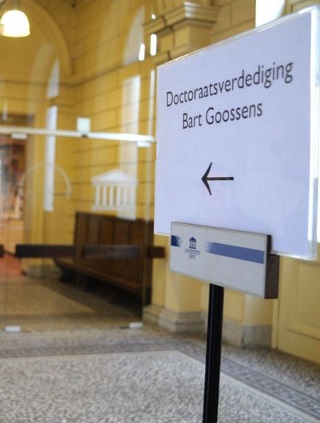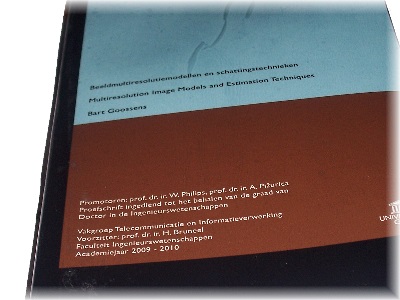I successfully defended my Ph.D. on May 10, 2010. The public defense took place in the Jozef Plateauroom of the Faculty of Engineering, Jozef Plateaustraat, Gent, Belgium. On Dec. 13, 2011, I received the Scientific Prize IBM Belgium for Informatics for my dissertation.
Members of the Jury
- Prof. Dr. Ingrid Daubechies (Princeton University)
- Prof. Dr. Paul Scheunders (University of Antwerp)
- Prof. Dr. Ir. Luc Taerwe (Ghent University, Dean of the Faculty of Engineering, chairman of the jury)
- Prof. Dr. Ir. Marc Moeneclaey (Ghent University, secretary)
- Prof. Dr. Ir. Wilfried Philips (Ghent University, promoter)
- Prof. Dr. Ir. Aleksandra Pizurica (Ghent University, promoter)
- Prof. Dr. Stefaan Vandenberghe (Ghent University)
- Dr. Ir. Hiep Luong (Ghent University)
- Dr. Lic. Ewout Vansteenkiste (Ghent University)
Pictures of the public defense:
Available here.

Abstract (English)
In the last decades, the use of digital images has tremendously increased, due to the wide availability of imaging devices, such as digital still cameras and medical scanners. Simultaneously, image quality expectations of end users have augmented. To meet these expectations, manufacturers of imaging devices push the electronics in their devices up to their limits. However, physical limitations and cost restrictions pose stringent limits on the maximum achievable image quality. Consequently, acquired digital images are imperfect and often contain many degradations, such as noise and blur. It becomes increasingly important to improve the quality of these degraded images and to extract more useful information out of these images.
In this dissertation we develop estimation techniques (such as noise suppression techniques) to restore images after acquisition. We thereby employ a generic methodology that can easily be adapted to various practical applications. Based on improved multiresolution representations, we develop and present new and improved statistical models for images and image noise. In this respect, one of the contributions of this thesis is a new statistical model for non-stationary noise in medical CT images. Because of the signal-dependency of the projection data noise and because of the non-local character of the traditional reconstruction algorithm, the statistics of noise in reconstructed CT images are very complicated. Our statistical model accurately describes these statistics, which is very useful for the quality enhancement of low dose CT images. Another contribution is the automatic quality assessment of medical images. The goal is to objectively and automatically measure image quality using a “virtual specialist”. Quality assessment is useful for validating image restoration techniques for medical images and for optimizing future medical display systems. In this dissertation, we present a novel framework for virtual specialist models for the detection of lesions with random parameters (e.g., orientation, size).
Abstract (Dutch)
De laatste decennia is het gebruik van digitale beelden sterk toegenomen als gevolg van de ruime beschikbaarheid van beeldopnametoestellen, zoals digitale camera's en medische scanners. Tegelijkertijd zijn ook de verwachtingen van de eindgebruikers over de beeldkwaliteit toegenomen. Om hieraan tegemoet te komen, trachten fabrikanten van beeldopnameapparatuur het maximale uit de elektronica in hun apparaten te halen. Maar omwille van fysische beperkingen en kostprijsredenen, is de maximaal haalbare beeldkwaliteit echter beperkt. Bijgevolg vertonen opgenomen digitale beelden vaak vele degradaties, zoals ruis en onscherpte. Het is dus steeds belangrijk om de kwaliteit van de imperfecte beelden te verbeteren om zo meer nuttige informatie uit deze beelden te halen.
In dit proefschrift worden schattingstechnieken (zoals ruisonderdrukkingstechnieken) ontwikkeld om opgenomen beelden te verbeteren, aan de hand van een generieke methodologie die gemakkelijk kan worden aangepast voor diverse praktische toepassingen en die gebaseerd is op verbeterde multiresolutievoorstellingen. Dit wordt mogelijk gemaakt door de nieuwe en verbeterde statistische modellen voor beelden en de bijhorende ruis, die ook in dit werk voorgesteld worden. Zo is één van de bijdragen van dit proefschrift een nieuw statistisch model voor niet-stationaire ruis in medische CT beelden. Omwille van de signaalafhankelijkheid van de projectiedata en het niet-lokale karakter van het traditionele reconstructiealgoritme, zijn de ruisstatistieken in gereconstrueerde CT beelden zeer ingewikkeld. Met behulp van ons statistisch model kunnen we deze statistieken nauwkeurig beschrijven, wat zeer nuttig is voor de beeldverbetering van lage dosis CT beelden. Een andere bijdrage is de automatische kwaliteitsbeoordeling van medische beelden. Het doel is hier om objectief en automatisch de beeldkwaliteit te bepalen met behulp van een “virtuele specialist.” Dit is nuttig voor zowel het valideren van beeldverbeteringstechnieken voor medische beelden als voor het optimaliseren van toekomstige medische beeldschermen. In dit proefwerk wordt een nieuw raamwerk voor virtuele specialistmodellen voor de detectie van laesies met willekeurige parameters (oriëntatie, schaal) voorgesteld.
Electronic version
Available at: https://biblio.ugent.be/publication/1009846/file/4335255

 website
website